thingsmagazine: This Must be the Place, Roy Lichtenstein, 1965
Read More"“Loop through the text and make a Dictionary, meaning key - value container. And put all pair..."
“
“Loop through the text and make a Dictionary, meaning key - value container. And put all pair of words as keys and the word following as a value. For example: if you have a text: “a b c a b k” you start with “a b” as key and “c” as value, then “b c” and “a” as value… the value should be a list or any collection holding 0..many ‘items’ as you can have more than one value for a given pair of words. In the example above you will have “a b” two times followed fist by “c” then in the end by “k”. So in the end you will have a dictionary/hash looking like this: {‘a b’: [‘c’,’k’], ‘b c’: [‘a’], ‘c a’: [‘b’]}
Now you have the needed structure for building your funky text. You can choose to start with a random key or a fixed place! So given the structure we have we can start by saving “a b” then randomly taking a following word from the value, c or k, so the first save in the loop, “a b k” (if “k” was the random value chosen) then you continue by moving one step to the right which in our case is “b k” and save a random value for that pair if you have, in our case no, so you break out of the loop (or you can decide other stuff like start over again) When to loop is done you print your saved text string.
The bigger the input, the more values you will have for you keys (pair of words) and will then have a “smarter bot” so you can “train” your bot by adding more text (perhaps chat input?). If you have a book as input, you can construct some nice random sentences.”
” How do Markov Chain chatbots work … reading about markov chain and book writing…
-
A presentation called “Many Tamagotchis Were Harmed in the...
A presentation called “Many Tamagotchis Were Harmed in the Making of this Presentation” by Natalie Silvanovich.
As the speaker puts its, it’s good lessons about “interfacing with devices you’re not supposed to interface with”.
Read MoreDark Patterns: User Interfaces Designed to Trick People
Dark Patterns: User Interfaces Designed to Trick People :
Presented at UX Brighton 2010 by Harry Brignull
Read More"If you view the mass adoption of 3D printing as an inevitability – whether it be through people all..."
“
If you view the mass adoption of 3D printing as an inevitability – whether it be through people all owning their own 3D printers or, more likely, paying by usage at a local 3D-printing store – then it follows that many more people will start ripping out and replacing static components of various devices, such as smartphones.
If that happens, then many less skilled practitioners of the art will start messing up said devices with parts that just don’t fit as well as they should. Nokia’s 3DK release should reduce that risk for customizers of Lumia 820 phone shells, making it more likely that they will remain satisfied with the overall product experience. It’s like releasing a solid SDK, only for hardware, and it’s a smart move on many levels.
” David Meyer at GigaOM about the release of 3D templates, case specs, recommended materials and best practices related to the Lumia 820 phone shell. Why do I blog this? Although I don’t necessary buy the “3D printing as an inevitability” argument, I’m intrigued by the consequences of such move by Nokia. Will users follow the best practices? Will there be any weird repurposing? Is that a weak signal of something that will be more general? I’m frankly not sure everyone will/can do it but it’s curious to think of “amateurs” trying things (as “choosing something on Thingiverse and modifying it a little bit”).
-
The Apple icon garden.
The Apple icon garden.
Read More“Did Google Kill this Donkey?” asks Jalopnik. The...
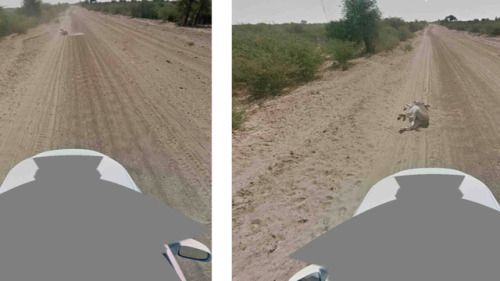
“Did Google Kill this Donkey?” asks Jalopnik. The answer is no:“Because of the way our 360-degree imagery is put together, it looked to some that our car had been involved in an unseemly hit and run, leaving the humble beast stranded in the road.
As our imagery below shows, the donkey was lying in the path - perhaps enjoying a dust bath - before moving safely aside as our car drove past. I’m pleased to confirm the donkey is alive and well.”
Read More"We live in a time when the loneliest place in any debate is the middle, and the argument over..."
“We live in a time when the loneliest place in any debate is the middle, and the argument over technology’s role in our future is no exception. The relentless onslaught of novelties technological and otherwise is tilting individuals and institutions alike towards becoming Engineers or Druids. It is a pressure we must resist, for to be either a Druid or an Engineer is to be a fool. Druids can’t revive the past, and Engineers cannot build technologies that do not carry hidden trouble.”
- “The Coming Fight Between Engineers And Druids” by Paul Saffo, in Edge: What should be we worried about?.
From Regine Debatty’s review of Bad Graffiti by Scott...
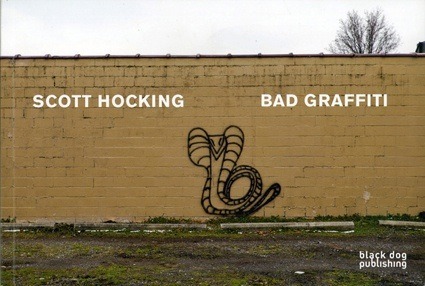

From Regine Debatty’s review of Bad Graffiti by Scott Hocking.
Why do I blog this? I’m fascinated by bad art/naive production and the sort of effect they produce. When it comes to graffiti, I’ve always been intrigued by the way ugly throw-ups, bad drawings and paint stains form a curious urban texture.
Read MoreSarif Industries trailer (ad for Deus Ex, a video game)
Sarif Industries trailer (ad for Deus Ex, a video game)
Read MoreKnight Rider’s red light interface. According to the...
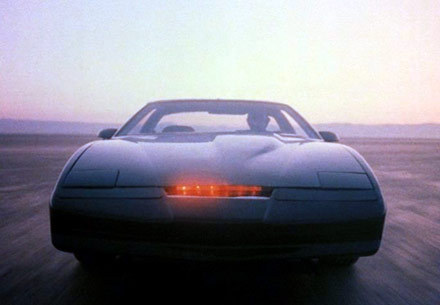

Knight Rider’s red light interface. According to the Wikipedia:
KITT’s scanner is similar to that of Cylons from the science fiction series Battlestar Galactica. Glen A. Larson, the creator of both Knight Rider and Battlestar Galactica has stated that the two shows have nothing else in common and to remove any fan speculation, he stated in the Season One Knight Rider DVD audio-comments, that he simply reused the scanning light for KITT because he liked the effect.
Why do I blog this? I’m currently in a seminar with design students and we are discussing interface from science-fiction pieces, their meaning and their implications. This example popped out as relevant.
Read More“Where did the Future Go?” by Alice Framis.
"… design-fiction comes with the history of conceptual design. Despite its name, it has nothing..."
““… design-fiction comes with the history of conceptual design. Despite its name, it has nothing in common with conceptual art. It is a parallel design activity which is not attained through production and which can be associated with the experiences of the Radical Italians in the 1960s, for example. This way of thinking occurs every time a group of designers are no longer satisfied by industrial production and its poverty of intellect. The path of ‘design-fiction’ allows one to be a designer differently by pursuing a parallel path.””
- Antony Dunne, interviewed by Alexandra Midal, in “Tomorrow Now - When Design Meets Science-Fiction” (2007)
“Hugo Gernsback wearing his TV Glasses in 1963 Life...
(via Stefano Mirti), as reported by Dezeen Royal College of Art...
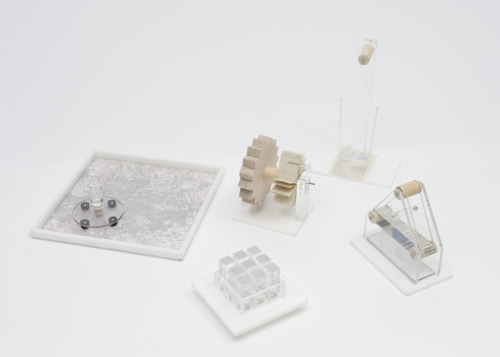
(via Stefano Mirti), as reported by Dezeen
Royal College of Art student Gabriele Meldaikyte has designed a set of interactive exhibits for a museum of iPhone gestures. “There are five multi-touch gestures forming the language we use between our fingers and iPhone screens,” says Meldaikyte. “This is the way we communicate, navigate and give commands to our iPhones.”. She used wood and acrylic to make five 3D objects that recreate the physical actions required to operate a touch-screen smartphone, using newspaper clippings, book pages and paper maps to represent the data being manipulated.
Why do I blog this? An interesting design research approach to highlight new interaction rituals. Surely a good complement to our curious ritual project with a more tangible format.
Read MoreVia wtbw: (via Unique Headphones for Studying Birds Hearing | I...
(via Pop-Up Urbain ) Do Computers Dream of Electronic...
(via Pop-Up Urbain ) Do Computers Dream of Electronic Sheep ? (2013) Directed by Benjamin Bardou Produced by Data Films Music composed by Steve Moore - Logos from “The Way In” album (1990 - Inner Ear Recordings) CGI from the videogame GTA IV (Rockstar Games/Take Two Interactive) Data Films - 2013
Why do I blog this? This is a fantastic depiction of computing with urban inserts from GTA. What is fascinating here is the way the different visuals create a new form of aesthetic, an alternative near-future world that merges past and present representations.
Read MoreStar Wars map by Andrew DeGraff.
Star Wars map by Andrew DeGraff.
Read More: Tbh I find this whole url culture Tumblr’s formed to be less annoying...
: Tbh I find this whole url culture Tumblr’s formed to be less annoying...:
Tbh I find this whole url culture Tumblr’s formed to be less annoying and more interesting. Like it’s just totally mind-blowing and genuinely fascinating to me that urls have developed their own barter system in the Tumblr community. People hunt down urls and keep them to themselves, and trade them for urls of “equal or greater value”. What determines value for a url? On what scale is it being measured, if any? Do people with lots of hoarded urls have more value on Tumblr than people like me who only have the one(s) I use right now? This is really cool I’m kind of excited I’ve finally got a window into this Tumblr black market, I’ve always had glimpses at it before but this is the first time I’ve ever really gotten into the nitty gritty of how it works.
Why do I blog this? Yesterday I found this term “URL culture” while browsing and I find it clearly encapsulates something intriguing about our current culture. “hoarded URL”, that sounds great.
Read MoreThe Bubble Bonnet, aka the Space Bubble Helmet: In 1964,...
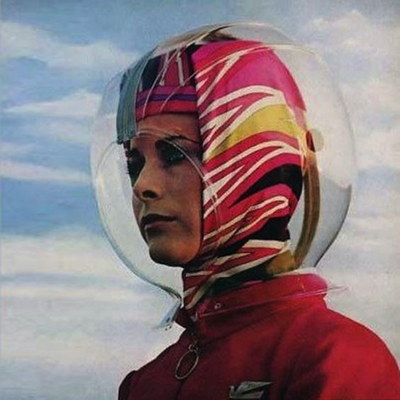
The Bubble Bonnet, aka the Space Bubble Helmet:
In 1964, Braniff airlines was looking for a way to differentiate itself from its competitors by adding a touch of glamour and weirdness to its service. So it hired Italian fashion designer Emilio Pucci to design the uniforms of the stewardesses. What he came up with was the plexiglass Bubble Bonnet, aka the Space Bubble Helmet. Its purpose was supposedly to protect the hair of the stewardesses from wind and rain as they crossed the tarmac. Stewardesses complained that it was hard to hear anyone while wearing the things.
Why do I blog this? It looks rather retro-futuristic now but I guess the designer was sincere at the time. A too heavy future though.
Read More
